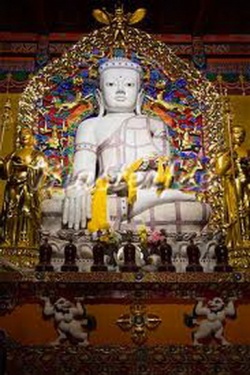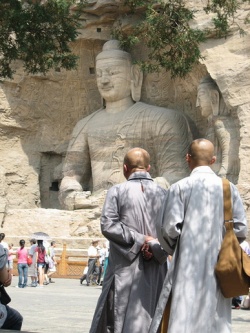Dependent Origination (paticca-samuppada) -The Wheel of Law (Life)
According to Buddhism, nothing can exist by itself except, but only in relation to other causally-related events: a particular result always has a cause. For example, cause A results in B, and B then acts as a cause for another result C. The patticca-samuppada is an important discourse on the process of birth and death of beings that operates within the above law. It deals with the cause of rebirth and suffering with the purpose of releasing beings from the cycle of life(samsara). It should be noted that it is not a theory of the evolution of the world.
This doctrine of Conditioned Genesis or Dependent Origination is unique to Buddhism.
1.Ignorance (avijja) of the truth of dukkha, its cause, its end and the way to its end is the chief cause that sets the wheel of life in motion. In other words, it is the lack of understanding of things* as they really are which makes us cling onto these very things that result in being trapped in the cycle of birth, death and re-birth (samsara). It should be noted that understanding here is not mere book knowledge, but a true intuitive realisation of the processes of life as they really are.
2.As a result of this lack of understanding, there arises samkhara. The Pali word samkhara has many meanings and does not translate directly into English. But in the context of Dependent Origination, it may be termed mental formations which generate kamma.
In general, Samkhara has a much broader and deep meaning than above. It is defined as "things that have come into existence due to causes and conditions that are subject to continuous change". It includes such factors as skillful and unskillful intentional actions, memory, habit formations set up in the past. All skillful and unskillful thoughts, words and actions are also included in this category. It could be said that samkhara is the momentum generated by the above factors that propels a being through samsara.
3.Dependent on past conditioning activities (samkhara) arises re-linking or re-birth consciousness (patisandhi-vinnana) in a subsequent birth. It is so called because it links the past life with the next one.
4.Simultaneously with the arising of the re-birth consciousness, there is the formation of mind and matter (nama-rupa). This interdependent combination is what constitutes a sentient living being. It follows that in order for a fertilized egg to develop into a living being, an essential factor is the re-birth consciousness. In this consciousness are latent all the past impressions and characteristics of that particular life-stream.
5.The mind-matter combination then goes on to develop the six senses (salayatana), comprising eye, ear, nose, tongue, touch and mind. In this context, mind is included as the sixth sense organ as it a receptor for thoughts and functions as a co-ordinater of the information received from other five senses.
6.Each of these senses gives rise to contact (phassa). Contact is the interaction of the particular sense organ with a corresponding external objects. For example, when the eye sees an object, its image falls on the retina, which produces visual stimulation. This is visual contact **.
Similarly, when a sound falls on the ear, auditory contact takes place. It should be noted that no identification of the object takes place at this stage: it is simply an awareness of the presence of the object.
7.Dependent on contact, sensation or feeling (vedana) arises. The feeling can be pleasant, unpleasant or neutral.
8.Dependent on feelings, craving (tanha) arises. Cravings or desires take three forms:
craving for sensual pleasures (kama-tanha), craving for continuation (bhava-tanha) and craving for self-destruction (vibhava-tanha).
It is this craving which is deep rooted in all sentient beings that conditions the future.
9.As a result of craving, attachment (upadana) arises, which takes form of sensuality, false views, attachment to rites and ceremonies, and belief in a permanent soul.
10.Attachment results in bhava, which literally means becoming (the drive for a life to come into being).
11.Dependent on becoming, birth (jati) takes place in a subsequent life. This is essentially the formation of the mind and matter (nama-rupa) combination.
12.The being so formed will be subject to change, undergo old age and eventually end in death (jara-marana).
Death is followed by re-becoming (rebirth) and the above process is repeated indefinitely until such time that we are able to develop the penetrating wisdom (sati panna) that dispel our lack of understanding* of the true nature of things, leading to the complete liberation from the cycle of existence (samsara) and attaining the state of Nibbana.
This cyclic process is often symbolically depicted as a wheel in Buddhist art - the Wheel of Life or the Wheel of Law (Dhammacakka), which can be seen as artefacts in Buddhist temples.

